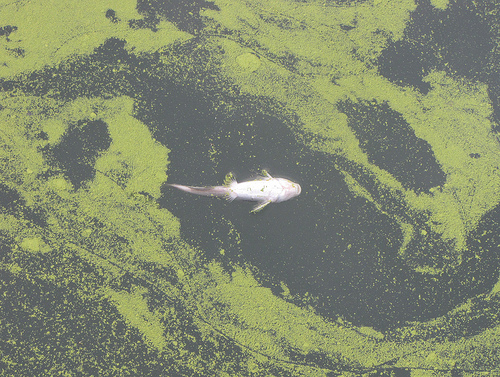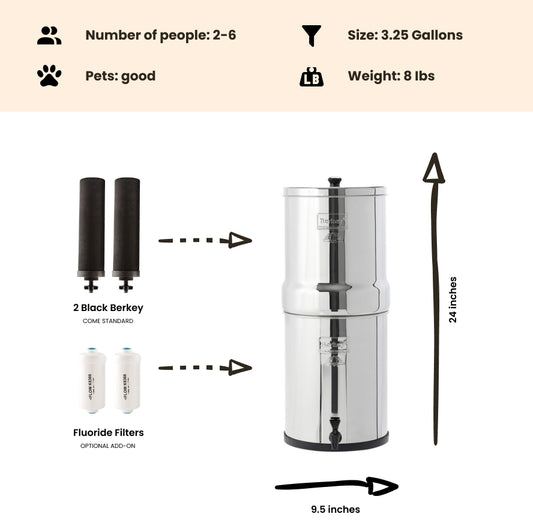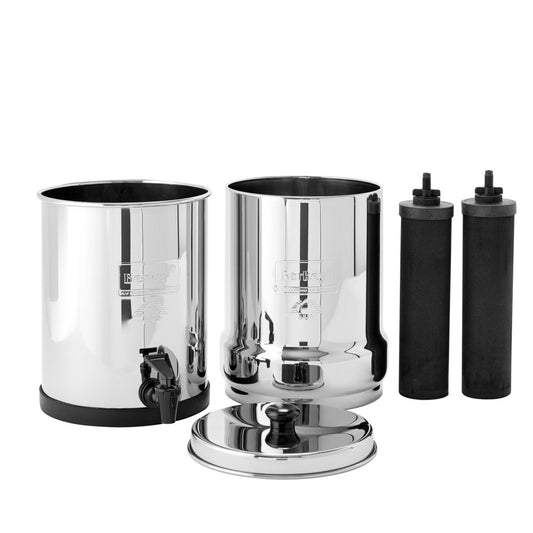Algae Bloom and Microcystin Removal – Berkey FAQ
By Dan DeBaunShare
Update 7/15/2019 - The Berkey filters do remove Microcystin and Cyanotoxins from the water. For information on how the Berkey water filter performs removing this algae, please see Berkey Algae Bloom and Microcystin Removal Testing Results found here.
Below is some information that might be helpful, with respect to the recent Algae Bloom and resulting contamination of the water supply to Toledo, Ohio: “…Cyanobacterial cells range in size from 0.5-1 μm to 40 μm in diameter…” In other words, it's a long skinny bacteria.
Reference: https://huey.colorado.edu/cyanobacteria/about/cyanobacteria.phpInternet research seems to indicate that cyanobacteria are even larger, typically on the scale of 150 micrometers in size. While we have not tested the specific microbes associated with Algae Blooms, we have tested other pathogenic bacteria and two viruses, which are a small fraction of the size of these microbes.
To understand the difference between the size of pathogenic bacteria and viruses, we suggest the following web link as it will give you a great visual of the difference.
The University of Utah Cell Size and Scale Chart: https://learn.genetics.utah.edu/content/cells/scale/Slide the scale at the bottom to see the size of virus vs bacteria vs other potential contaminates and magnify to greater levels. Black Berkey purification elements have been tested to remove both pathogenic bacteria and viruses to greater than the EPA purification standards.
This suggests that larger bacteria, such as cyanobacteria, should also be effectively removed. Without test data on that specific microbe however, NMCL does not make that specific claim. The MS-2 virus is 24-26 nm in size. The Fr Coliphage virus is 25nm in size. In other words, they are over 1,000 times smaller than Cyanobateria. Additionally Microcystins, which are the chemical contaminates resulting from cyanobacteria are an organic chemical. Testing of Black Berkey elements has demonstrated they are extremely efficient at removing organic chemicals.
Reference: https://iaspub.epa.gov/tdb/pages/contaminant/contaminantOverview.docThe EPA defines Microcystins as: “…toxins produced by cyanobacteria. Cyanobacteria are also known as blue-green algae and are ubiquitous in surface water when conditions are favorable for growth and formation of algal blooms. Cyanobacteria release toxins upon cell death or lysis. When released, toxins may persist for weeks to months. Toxins of most concern are microcystins. Microcystins take their name from the genera Microcystis. Most microcystins are hepatotoxins (liver toxins). Hepatotoxins are produced by species of the genera Microcystis, Anabena, Nodularia, Oscillatoria among others. Most microcystins are associated with Microcystis aeruginosa. While the liver is the primary target of microcystins, it is also a skin, eye and throat irritant…”
Further, the EPA states that: “…The following processes are considered effective for the removal/oxidation of microcystin:…. powdered activated carbon (up to 100% for some microcystins but less so for others), granular activated carbon (time-dependent from 100% near start up to 38 to 73% at 3.5 months…”Reference: https://iaspub.epa.gov/tdb/pages/contaminant/treatmentSummary.do
Finally, the EPA states that: “…Removal of total microcystins, M-LR, and M-LA, in water by granular activated carbon (GAC) can be very effective where the effectiveness is based on the empty bed contact time, the carbon's age, and possible biodegradation of the toxin. Time-dependent monitoring in a full-scale plant ranged 43 to 60 percent removal for M-LR. Time-dependent monitoring in pilot-scale studies ranged from greater than 99 percent at one month to 73 percent at 3.5 months for M-LR, and from greater than 99 percent at one month to 38 percent at 3.5 months for M-LA…”Reference: https://iaspub.epa.gov/tdb/pages/contaminantProcess/contaminantProcessOverview.do Based upon the above Internet research, Black Berkey element microbe and organic chemical removal test data and the information provided by the EPA in their reference material cited above; these all suggest that Berkey water purification systems should be extremely effective at removing and reducing contaminates resulting from the current algae bloom. NMCL also highly recommends that whenever possible, the cleanest source water available should always be utilized. Update 7/15/2019 - The Berkey filters do remove Microcystin and Cyanotoxins from the water. For information on how the Berkey water filter performs removing this algae, please see Berkey Algae Bloom and Microcystin Removal Testing Results found here.
-
Regular price $234.00 USDRegular priceUnit price / per
-
Regular price $327.00 USDRegular priceUnit price / per
-
Regular price From $367.00 USDRegular priceUnit price / per
-
Regular price From $408.00 USDRegular priceUnit price / per
-
Regular price From $451.00 USDRegular priceUnit price / per
-
Regular price From $478.00 USDRegular priceUnit price / per
-
Regular price $332.50 USDRegular priceUnit price / per
$350.00 USDSale price $332.50 USDSale

Dan DeBaun
Dan DeBaun is the owner and operator of Big Berkey Water Filters. Prior to Berkey, Dan was an asset manager for a major telecommunications company. He graduated from Rutgers with an undergraduate degree in industrial engineering, followed by an MBA in finance from Rutgers as well. Dan enjoys biohacking, exercising, meditation, beach life, and spending time with family and friends.
~ The Owner of Big Berkey Water Filters

















With cyanotoxins becoming a more common problem not only in the United States but around the world, I think there are many of us in the Berkey community that would like to see Berkey officially test the effectiveness at removing cyanotoxins. More and more communities are trying to deal with this issue. Our city in Salem, Oregon appears to be able to test for the presence of cyanotoxins and is using an in-house ELISA testing system and there is more information at https://www.cityofsalem.net/Pages/water-quality-test-data.aspx. Couldn't Berkey take the next steps using this system for testing?
Thank you.
Hi Andrea -
Testing for removal of microcystin has recently been completed. <a href="https://www.bigberkeywaterfilters.com/black-berkey-microcystin-lr-toxin-and-microcystis-algae-lab-results" rel="nofollow">Testing can be fond here</a>.
Thanks
Dan
Would you personally drink water that came from a lake with toxic algae bloom that had been through a Berky water bottle filter system? You personally, yes or no?
Hi Chelsea -
Yes, we personally would, but please do not take that as en endorsement. For liability and safety reasons, we do not recommend using the filters in any matter that has not been tested to be effective by NSF/EPA certified labs.
Thanks
DAn
Hi, I linked our current water situation because I researched the Berkey about a week ago and now wanted to know it's effectiveness for removing the Algae Blooms you are discussing here. I see there are two places our city is sending water samples to be tested with the lead time being about 1 week before our city knows if the water is safe to drink or not.
Perhaps Berkey can send their systems to these labs for testing so we can get a definitive answer as to whether their systems can truly remove the microcystins/cyanobacterial blooms? I would sure like to know, we had already decided to purchase a Berkey when we were able to come up with the money for it because we buy reverse osmosis water at the windmill already. We have never liked our city water and the chlorine smell is enough to knock me over but I am also sensitive to chemicals due to my medical conditions I have. So drinking city water is the last thing I want to do.
Anyway, please Berkey let me know if you have done any further testing regarding this type of algae bloom emergency.
Here is the city website link and below the link is copied and pasted information direct from the website regarding the algae bloom our city is experiencing right now.
http://inglesidetx.gov/do-not-drink-the-water-this-is-not-a-boil-water-notice/
In the LIMITED AREA on the map
Do Not Drink the Water
(Do NOT boil water, it will not help)
See Update below.
Due to unsafe drinking water conditions in specific streets in the North Eastern area of town, consumers are directed to Not Drink the Water. This includes making ice cubes, food preparation, brushing teeth or any other activity involving ingestion of water. This Order shall remain in effect until further notice. Also, see update below.
Areas in concern are:
Kenny Ln from Ave A to Hwy361
12th Street from Ave A to Hwy361
Indian Trail from Avenue A to Hwy361
Pinoak
Lenore
Cardinal Circle,
Kelly
Hackberry
Questions regarding this notice should be directed to:
Public Works (361)776-7409
After hours:
Donald Paty (361)443-4346
Chris Burke (361)523-9831
John Meenaghan (361)877-5250
UPDATE
01/30/2016 at 4:30 p.m.
We are working on two (2) suspect areas and the City is installing additional backflow preventers in order to isolate the source of the possible contamination. We are flushing the lines and routinely sampling in order to test the area.
We want to give a special thank you to the City of Rockport, the City of Corpus Christi, and the San Patricio Municipal Water District for their assistance in these ongoing efforts.
To sign up for Emergency and General City Notifications, please go to www.coastalbendcan.org and click on the Residents Link.
Health Effects Information for microcystins:
Effects including gastroenteritis, and liver and kidney damage have been reported in humans following short-term exposure to microcystins/cyanotoxins in drinking water. Recreational exposure to microcystins/cyanobacterial blooms has been reported to lead to allergic reactions, including hay fever-like symptoms; skin rashes; and gastrointestinal distress. Animal studies have shown that long-term adverse effects from microcystins/cyanotoxins include liver and kidney damage. However, more research is ongoing to quantify these effects.
Where can I find more information?
To learn more about the HAs for microcystins and cylindrospermopsin and to view the health effects support documents for these and anatoxin-a in drinking water, visit EPA’s
Health Advisory webpage: http://water.epa.gov/drink/standards/hascience.cfm
To learn about additional strategies Public Water Systems and others could consider in managing cyanotoxins, visit EPA’s CyanoHABs website: http://www2.epa.gov/nutrient-policydata/guidelines-and-recommendations
Ingleside City Hall | 2671 San Angelo
P.O. Drawer 400 | Ingleside, Texas 78362
Phone: 361-776-2517 | Email: Contact Us
Hi Suzy -
Unfortunately no further testing has been done for microcystin removal. This is primarily because the company has not found a lab that has adequate and proper protocols in place for testing commercial water filters for this removal.
Thanks
Dan
I live near Toledo and I have a well for my water. Where can I have the water tested and at what cost?
Hi Carol -
You would have to perform this research locally as we do not have a master list of testing facilities and the prices they charge.
Thanks
Dan
Have you done any testing on the Berkys effectiveness and removing Microcystine (sp) from water?
I live near Toledo Ohio and get their water. I also own a big Berkey but have been drinking bottled water b/c although you have a lot of info here The effectiveness of the Berkey system on Microcystin still seems inconclusive. Is there going to be any testing done on the specific toxin and if so when?
Thanks
Hi Kate -
Currently there are no labs that test for this toxin to EPA/NSF standards since these organizations have not established guidelines yet. All Berkey filters are tested to these EPA/NSF standards, so testing cannot be scheduled until this is available, and thus there is no timetable.
Thanks
Dan